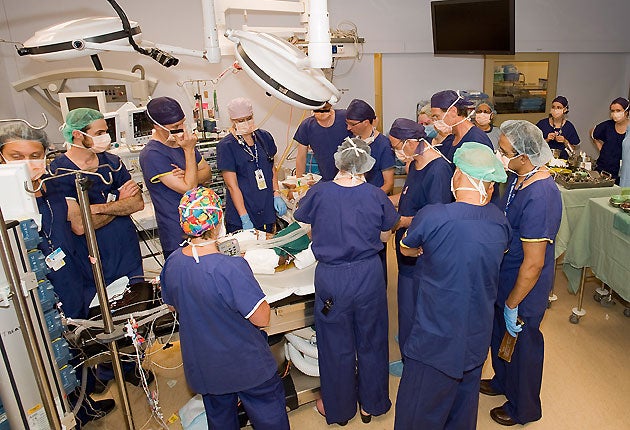Conjoined twins separated successfully

Your support helps us to tell the story
From reproductive rights to climate change to Big Tech, The Independent is on the ground when the story is developing. Whether it's investigating the financials of Elon Musk's pro-Trump PAC or producing our latest documentary, 'The A Word', which shines a light on the American women fighting for reproductive rights, we know how important it is to parse out the facts from the messaging.
At such a critical moment in US history, we need reporters on the ground. Your donation allows us to keep sending journalists to speak to both sides of the story.
The Independent is trusted by Americans across the entire political spectrum. And unlike many other quality news outlets, we choose not to lock Americans out of our reporting and analysis with paywalls. We believe quality journalism should be available to everyone, paid for by those who can afford it.
Your support makes all the difference.A team of 16 surgeons and nurses successfully concluded 25 hours of delicate surgery today to separate twin Bangladeshi girls who had been joined at their heads, sharing blood vessels and brain tissue.
It is too early to know whether the two-year-old girls, Trishna and Krishna, suffered any brain damage during the marathon operation — an outcome doctors said had a 50-50 chance. The girls will remain in an induced coma for monitoring for several days after the completion of the surgery.
The medical team began the work Monday morning on separating the girls, who were brought to Australia as infants by an aid organization.
"The teams managed to separate their brains and they are both very well," Royal Children's Hospital chief Leo Donnan told reporters. "Now we have the long task of the reconstructive surgery, which will go on for many hours."
Plastic surgeons finished reconstructing the girls' skulls using a combination of their own skin, bone grafts and artificial materials about five hours after the separation surgery ended.
"Their bodies have to recover from this, and we've got a lot of unknown territory we're moving into," Donnan said. "All I can say is that everything is in place for the best possible outcome. The main thing is that the girls are healthy."
Earlier Tuesday, Ian McKenzie, a member of the surgical team, said the girls were improving as their bodies began to work individually.
"The twins are actually in better condition because the degree of separation has increased and this problem we've had with their circulation affecting each other has actually gotten less," he said.
The girls shared parts of their skull, brain tissue and blood flow.
Before the surgery, doctors had said there was a 50 percent chance the girls could suffer brain damage and a 25 percent chance one of the sisters would die.
They were found in an orphanage in Bangladesh in 2007 by a representative from the Children First Foundation, who brought to them to Australia.
Join our commenting forum
Join thought-provoking conversations, follow other Independent readers and see their replies
Comments